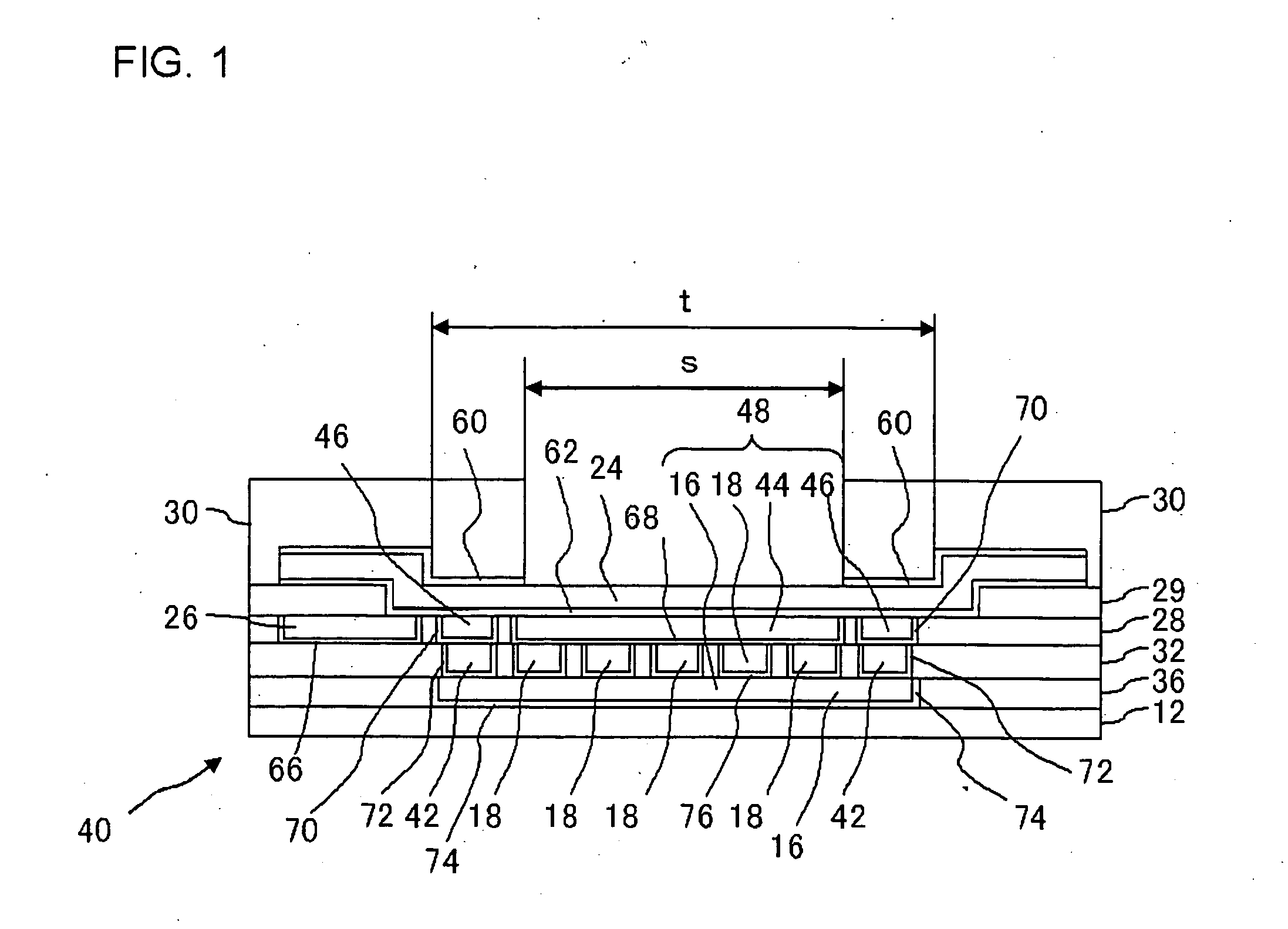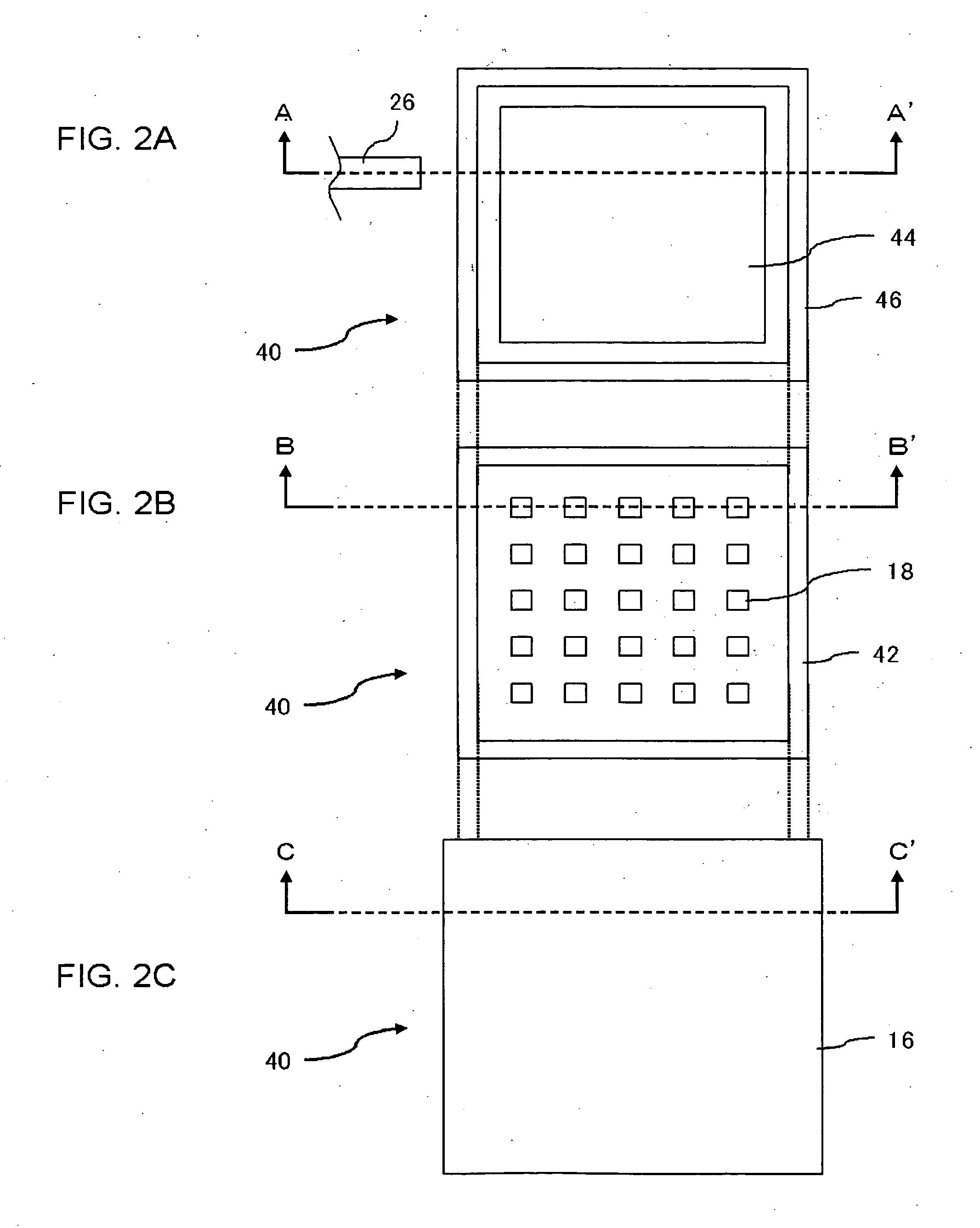Semiconductor device
a technology of semiconductor devices and devices, applied in semiconductor devices, semiconductor/solid-state device details, electrical apparatus, etc., can solve the problems of cracks on the bonding pad itself or on the lower face, lack of remedy for preventing cracks, and easy cracks on the bonding pad itself, so as to prevent corrosion of the interconnect and reduce the influence of cracks. , the effect of reducing the influence of the impa
- Summary
- Abstract
- Description
- Claims
- Application Information
AI Technical Summary
Benefits of technology
Problems solved by technology
Method used
Image
Examples
first embodiment
[0032]FIG. 1 is a schematic cross-sectional view showing a part a semiconductor device according to a first embodiment of the present invention, and FIGS. 2A to 2C are plan views showing interlayer dielectrics 28, 32 and 34, respectively, according to the first embodiment.
[0033] The semiconductor device according to this embodiment includes a bonding pad 24 serving as an external connection terminal, a region (under the bonding pad) 48 including, under the bonding pad 24, a first copper layer 44 and a second copper layer 16 located under the bonding pad 24, corresponding to at least two copper layers, as well as connection via plugs 18 provided so as to connect the first copper layer 44 and the second copper layer 16, a seal ring 42 constituted of an annular conductor disposed so as to surround the region under the bonding pad 48, and connecting the second copper layer 16, which is the lower copper layer in the pair, to the first copper layer 44, which forms a pair with the second ...
second embodiment
[0071]FIG. 5 is a schematic cross-sectional view showing a part a semiconductor device according to a second embodiment of the present invention.
[0072] A semiconductor device 10 according to the second embodiment has basically the same structure as the semiconductor device 40 according to the first embodiment shown in FIG. 1. A difference is that the first copper layer 44 and the seal ring copper layer 46, separately formed in the insulating interlayer 28 in the first embodiment, are continuously formed to constitute a unified first copper layer 22.
[0073] Also, the semiconductor device 10 can be fabricated through substantially the same steps as those taken in the first embodiment.
[0074] Providing thus a region under the bonding pad 34, including the first copper layer 22, a plurality of connection via plugs 18 and the second copper layer 16 so as to directly contact the lower face of the bonding pad 24 allows absorbing an impact imposed by inspections before the shipment and by ...
third embodiment
[0078]FIG. 6 is a schematic cross-sectional view showing a part of a semiconductor device according to a third embodiment of the present invention.
[0079] A semiconductor device 90 according to the third embodiment includes a multilayer interconnect 80 disposed under the semiconductor device 40 according to the first embodiment, and a silicon substrate 86, which serves as the base substrate of this semiconductor device, disposed in contact with a lower face of a lowermost insulating interlayer 82. In the silicon substrate 86, an MOS (metal oxide semiconductor) 84 which is an electronic device, may be located at a position corresponding to the opening of the semiconductor device 40 serving as an external connection terminal.
[0080] As described above, the semiconductor device 40 according to this embodiment is sufficiently reliable for locating electronic components right under the bonding pad. Employing the semiconductor device 40 as a section to constitute a bonding pad for connect...
PUM
 Login to View More
Login to View More Abstract
Description
Claims
Application Information
 Login to View More
Login to View More - R&D
- Intellectual Property
- Life Sciences
- Materials
- Tech Scout
- Unparalleled Data Quality
- Higher Quality Content
- 60% Fewer Hallucinations
Browse by: Latest US Patents, China's latest patents, Technical Efficacy Thesaurus, Application Domain, Technology Topic, Popular Technical Reports.
© 2025 PatSnap. All rights reserved.Legal|Privacy policy|Modern Slavery Act Transparency Statement|Sitemap|About US| Contact US: help@patsnap.com



